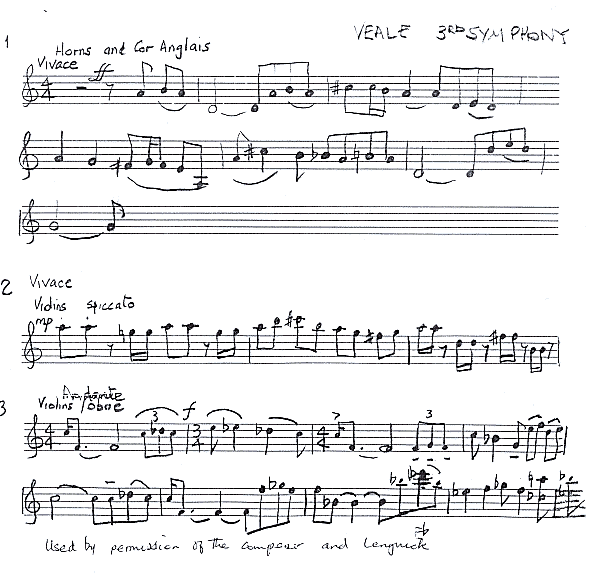JOHN VEALE'S THIRD
SYMPHONY
Dr David C F Wright
I am probably the least suitable person
to write about John Veale's Symphony
no. 3 since it is dedicated to me.
His previous two symphonies had left
the composer with the conviction that
he still had something to say symphonically
and, to some extent, this symphony represents
a synthesis, in a structural sense,
of the previous symphonies and other
earlier pieces. But, it has to be said,
that composing another symphony was
to satisfy the inner creative need!
He regards this latest symphony as a
sequel to the previous two.
He began it in 1995 and completed it
in 2003. It took a long time to compose
because John was having treatment for
cancer including surgery and enduring
various other problems and because he
agonises over his work and takes time
to perfect it. A good composer does
not really enjoy composing but such
work alternates between compulsive agonising
and euphoric spiritual purgation.
As with all of Veale's work there is
an inner strength, a pulse, an awareness
both of life and of the world since
his music is vital however irreducibly
modest and minimal it is, which is probably
the real function of the arts.
His previous big orchestral work, ‘Demos
Variations’, represents a detached observation
of humanity. The Symphony no. 3 suggests
an involvement with humanity. John is
a humanitarian objecting to the immoral
and illegal war in Iraq and other similar
conflicts and of all of man's inhumanity
to his fellows.
The symphony is scored for three flutes,
the third doubling piccolo, two oboes,
cor anglais, two clarinets, bass clarinet,
two bassoons, double bassoon, four horns,
three trumpets, three trombones, tuba,
timpani, three percussionists (cymbals,
tenor drum, bass drum, tam-tam and xylophone)
harp and string orchestra. It runs into
103 pages of score and lasts about 17
minutes. It is diatonic and lends itself
to the key of D. It plays continuously.
The opening is marked Vivace commencing
with a timpani figure (bars 1 to 7)
which constitutes the backbone of the
symphony. In the finale, which begins
with a fugue, the opening timpani music
is recalled in fragments under the exposition
of the fugue thus giving the work a
cyclic element, and is the evidence
of the inner strength of this composer's
music. It is the pulse, the heartbeat
of life itself since music has got to
be a living thing not a corpse. There
are three main themes, bar 7 to figure
1; secondly, bar 7 after figure 25 to
bar 10. This theme is prefigured at
bar 5 after figure 2 and passim thereafter;
thirdly, bar 5 after figure 20 with
flutes, cor anglais, clarinets, violas
and cellos, initially as a counter-theme
but thereafter becoming a theme in its
own right.
These themes are set out as musical
examples at the end of this discourse.
The music is hugely enjoyable and predominantly
cheerful. The orchestration is noted
for its clarity, as usual, and it is
never overblown or bombastic and never
succumbs to pomposity. There are moments
of tenderness and of controlled excitement.
The three sections, two vivaces with
a slow andante in the middle, are well
integrated and the music has an effortless
flow.
It is a fine symphony vastly superior
in many ways to symphonies which are
played regularly and available on commercial
recordings.

"Copyright David
C F Wright 2003. This article or any
part of it must not be copied , quoted,
used in any way , stored in any retrieval
system or downloaded without obtaining
the prior permission of the author.
Failure to comply could lead to action
at a law."
see also John
Veale Biography by David Wright

